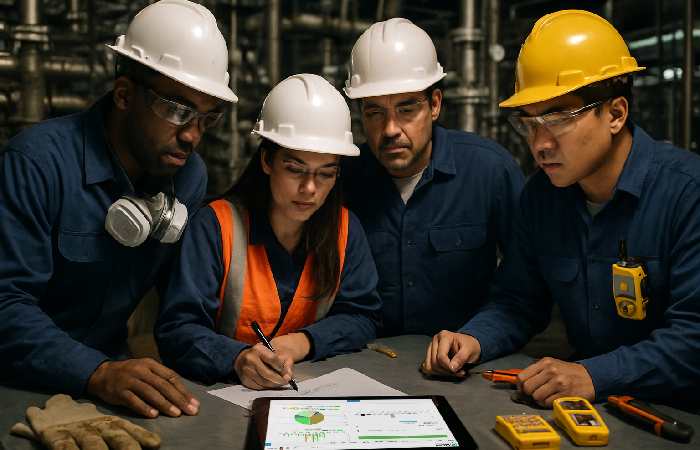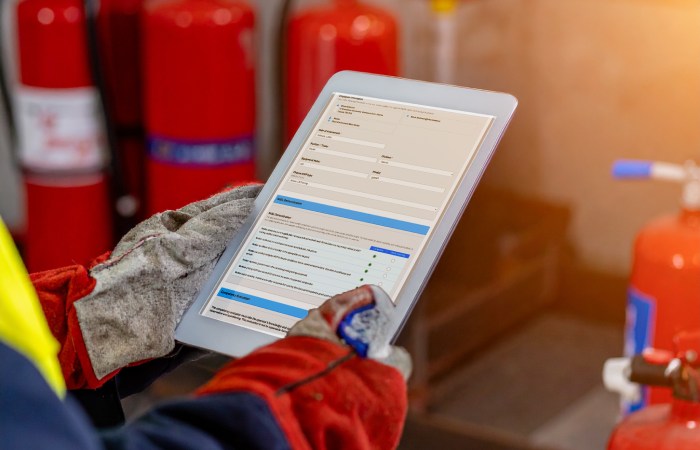In the seconds before a valve is turned on a pressurized pipeline, before a welder strikes an arc in a confined space, or before a crane lifts a critical load over an active facility, a silent, disciplined process must unfold. This process is the last and most critical line of defense against catastrophe. It is the orchestrated practice that separates a routine day from a life-altering disaster. This is Control of Work (CoW).
In high-hazard industries like oil & gas, mining, chemicals, utilities, and heavy manufacturing, risk is an inherent part of the operational landscape. While a high-level Safety Management System (SMS) provides the overarching strategy and policies for safety, Control of Work is where those policies meet the harsh reality of the field. It is the practical, hands-on framework that ensures high-risk work is meticulously planned, formally authorized, safely executed, and properly completed.
This deep dive will explore the essential pillars of a robust CoW system, explain why it is the absolute backbone of operational safety, and reveal how modern digital solutions, particularly the integrated platform from BIS Safety Software, are transforming this critical process from a bureaucratic hurdle into a powerful competitive advantage.
The Pillars of Control: Deconstructing the CoW Framework

Control of Work is not a single document or checklist. It is an integrated system of processes, each serving a distinct purpose in building layers of protection around a hazardous task. A world-class CoW system is built upon these interdependent pillars:
- Hazard Identification and Risk Assessment (The Foresight): Before any work begins, you must first understand the dangers. This pillar involves a systematic process of identifying potential hazards and assessing the associated risks. The most common tool here is the Job Hazard Analysis (JHA) or Job Safety Analysis (JSA). This isn’t a theoretical exercise; it’s a detailed, step-by-step examination of the task.
- Real-World Example: A maintenance team is tasked with replacing a pump in an area where flammable liquids are occasionally present. A thorough JHA would identify not only the obvious mechanical risks (crushing, stored energy) but also the potential for sparks from tools to ignite residual vapors, the need for specific personal protective equipment (PPE), and the requirement for a gas monitor to be present throughout the job.
- The Permit to Work System (The Formal Agreement): The Permit to Work (PTW) is the heart of the CoW system. It is a formal, written document—a contract for safety—that authorizes specific work to be carried out at a specific time and place. It details the hazards involved and prescribes the precise control measures required to keep people safe. It ensures that everyone, from the site authority to the frontline worker, has a shared understanding of the risks and the rules of engagement.
- Real-World Example: A “Hot Work Permit” for welding would explicitly state the duration of the permit, the exact location, the requirement for a fire watch, the proximity of fire extinguishers, confirmation that nearby combustible materials have been removed or shielded, and the signatures of both the issuer and the person performing the work.
- Isolation Management / Lockout-Tagout (The Ultimate Safeguard): Many of the most severe industrial accidents are caused by the unexpected release of hazardous energy. Isolation Management, often executed through a Lockout-Tagout (LOTO) procedure, is the process of ensuring that all energy sources—electrical, mechanical, hydraulic, pneumatic, chemical, or thermal—are identified, de-energized, and physically secured in a “zero energy state” before work begins.
- Real-World Example: Before a mechanic can work on an industrial conveyor belt, the electrical breaker feeding the motor must be turned off, locked in the “off” position with a physical padlock that only that mechanic has the key to, and tagged with their name and the reason for the lockout. This prevents anyone from accidentally re-energizing the machine while they are in a hazardous position.
- Shift Handover and Communication (The Unbroken Chain): High-hazard operations often run 24/7. A poorly managed handover between shifts is a major source of risk. Critical information about the status of equipment, ongoing permits, isolations in place, or any unusual conditions must be communicated flawlessly. An assumption made by an incoming shift can have devastating consequences.
- Real-World Example: A day shift crew places a critical process sensor into a manual override to perform a calibration. If they fail to clearly communicate this in the shift handover log and verbally to the incoming night shift, the new crew may operate the system under the false assumption that all safety systems are fully functional, potentially leading to a major process safety event.
- Simultaneous Operations (SIMOPS) Coordination (The Deconfliction): Sometimes, two or more independent work activities, each deemed safe on its own, can create a new, amplified set of risks when performed in the same area at the same time. SIMOPS coordination is the process of identifying and managing these potential conflicts.
- Real-World Example: A team performing excavation work (a safe job) and a team operating a large mobile crane to lift materials (also a safe job) are scheduled in the same area. The SIMOPS process would identify the unacceptable risk of the crane operating over the trench, potentially causing a collapse, and would mandate that these two jobs cannot happen concurrently.
Why an Ironclad CoW System is Non-Negotiable

Getting Control of Work right is fundamental to the survival and success of any high-hazard operation. Its importance extends far beyond just safety metrics.
- A Bulwark Against Catastrophe: First and foremost, CoW is about preventing Serious Injuries and Fatalities (SIFs). It provides the structured discipline needed to anticipate and control the high-consequence risks that can lead to life-altering events.
- Protection of Assets and Uptime: Improperly executed work can lead to catastrophic equipment damage, unplanned facility shutdowns, and massive production losses. A robust CoW system ensures that work done correctly and safely, protecting the physical assets that generate revenue and ensuring operational continuity.
- An Unimpeachable Compliance Record: Regulators in high-hazard industries demand rigorous adherence to safety standards. A well-documented CoW system, with its detailed permits, risk assessments, and audit trails, provides irrefutable evidence of due diligence and proactive risk management, which is invaluable during an audit or in the aftermath of an incident.
- A Culture of Disciplined Execution: Control of Work is where safety culture forged. When workers consistently participate in risk assessments, adhere to permit procedures, and verify isolations, a culture of disciplined, professional execution becomes ingrained. This builds trust between management and the frontline, improves morale, and empowers workers to stop any job they feel is unsafe.
The Digital Revolution: The BIS Safety Software Advantage

For decades, CoW systems managed with paper forms, clipboards, and binders. This analog approach is slow, prone to error, lacks visibility, and makes trend analysis nearly impossible. Today, leading organizations are embracing digitalization to overcome these challenges, and BIS Safety Software stands at the forefront of this transformation.
BIS Safety Software converts the entire Control of Work framework from a fragmented, paper-based burden into a streamlined, integrated, and intelligent digital ecosystem.
- From Paper Purgatory to Digital Precision: With the BIS Digital Forms module, you can digitize every element of your CoW system—permits, JHAs, LOTO forms, and checklists. This ensures that forms are never lost, are always legible, and follow a standardized, mandatory workflow.
- Real-Time Visibility and a “Control Tower” View: A supervisor or plant manager can access a real-time dashboard showing every active permit across the site. They can see what work is happening, where it is happening, who authorized it, and what critical controls are in place. This level of situational awareness is impossible with paper.
- Empowering the Frontline with Mobile Functionality: Using the BIS mobile app, a worker in the field can raise a permit request, complete a JHA, verify isolations (even using QR codes on equipment), and sign off on work directly on their tablet or smartphone. This brings the system to the work front, increasing efficiency and ensuring real-time data capture.
- Seamless Integration for Total Assurance: The true power of BIS lies in its integration. The Control of Work system connects directly to the Training Management and Contractor Management modules. This allows the system to automatically verify that any person assigned to a permit has the required, valid certifications to perform that work. It can prevent a permit from even issued to an unqualified or non-compliant worker or contractor—a critical layer of automated safety.
- Automated Workflows and Approvals: The platform automates the entire permit lifecycle. Once a request submitted, it is automatically routed to the necessary approvers based on pre-defined rules. This dramatically speeds up the authorization process while ensuring that no steps are ever skipped.
By adopting a digital platform like BIS Safety Software, you transform your Control of Work system from a static record-keeping exercise into a dynamic, real-time risk management engine.
Conclusion: From Intention to Action, Every Job, Every Time
Control of Work is the operational heart of any effective Safety Management System. It is the critical point where high-level policies and intentions translated into safe actions in the field. It is the disciplined framework that ensures the promise of sending every worker home safe at the end of the day becomes a reality.
While the principles of CoW are timeless, the tools to execute it have revolutionized. Relying on paper in today’s complex industrial environment is no longer a viable option. A digital, integrated, and mobile-first Control of Work system is now a strategic necessity for any organization serious about protecting its people, its assets, and its reputation.
By embracing a solution like BIS Safety Software, you equip your team with the tools to manage risk with precision, visibility, and unparalleled efficiency. You build a culture of accountability and empower every worker to be a leader in safety. This is how great organizations turn good intentions into safe outcomes—every job, every time.

